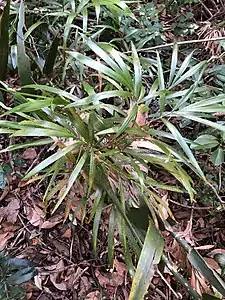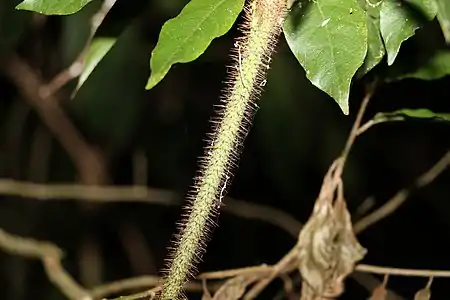Calamus muelleri
Calamus muelleri, commonly known as southern lawyer cane or wait-a-while, is a climbing palm with a vine-like habit, endemic to the subtropical coastal rainforests of northern New South Wales and southern Queensland. Sharp hooks on the plant can snag the clothing of walkers in these forests, giving rise to the name "wait-a-while".
| Southern lawyer cane | |
|---|---|
 | |
| In Nightcap National Park | |
 | |
| Habit | |
| Scientific classification | |
| Kingdom: | Plantae |
| Clade: | Tracheophytes |
| Clade: | Angiosperms |
| Clade: | Monocots |
| Clade: | Commelinids |
| Order: | Arecales |
| Family: | Arecaceae |
| Genus: | Calamus |
| Species: | C. muelleri |
| Binomial name | |
| Calamus muelleri | |
Description
C. muelleri is a clustering, climbing palm growing up to 20 m (66 ft) in length, with thin stems up to 16 mm (0.63 in) diameter. The pinnate fronds are alternate and more or less sessile.[4] They are up to 1 m (3 ft 3 in) long with 7-13 leaflets on each side and have long recurved spines on the rachis. The leaflets have spines along the midrib on the upper surface and small sharp spurs on their margins. The leaf sheath is densely covered in spines.[4][5][6]
This species, like others in the genus, produces a modified sterile inflorescence (known as a flagellum)[7] up to 1.2 m (3 ft 11 in) long,[4][6] which is armed with dozens of strong, recurved barbs that act like grappling hooks to latch on to nearby vegetation and provide support for the plant.[4][7]
Fertile inflorescences are up to 1 m (3 ft 3 in) long and flowering occurs in all months of the year.[5] The fruits are a globose drupe about 12–16 mm (0.47–0.63 in) in diameter, containing a single seed.[4][5][6]
Taxonomy
The southern lawyer cane was first described by the German botanist and noted authority on Arecaceae Hermann Wendland, based on specimens collected by Hermann Beckler and others on the Brisbane River and Moreton Bay in Queensland and on the Clarence and Richmond Rivers in New South Wales. Wendland's work was published in the journal Linnaea; Ein Journal für die Botanik in ihrem ganzen Umfange in 1875.[8][9]
Distribution and habitat
Calamus muelleri grows in rainforests and wet sclerophyll forests in subtropical eastern Australia, from around Gympie in Queensland south to the Bellinger and Hastings Rivers in New South Wales.[5][6]
Ecology
Laetesia raveni, a species of spider endemic to eastern Australia, builds its web only in two plant species, Calamus muelleri and Solanum inaequilaterum, both of which are spiny plants.[10]
Conservation
This species is listed by the Queensland Department of Environment and Science as least concern.[1] As of 4 December 2021, it has not been assessed by the IUCN.
Uses
Aboriginal Australians used the cane stems for weaving.[6]
Gallery
 Young plant
Young plant Spines
Spines Stem
Stem Leaf rachis
Leaf rachis Stem
Stem
References
- "Species profile—Calamus muelleri". Queensland Department of Environment and Science. Queensland Government. 2021. Retrieved 4 December 2021.
- "Calamus muelleri". Australian Plant Name Index (APNI). Centre for Plant Biodiversity Research, Australian Government. Retrieved 4 December 2021.
- "Calamus muelleri". Plants of the World Online. Royal Botanic Gardens, Kew. Retrieved 4 December 2021.
- Harden, Gwen; Williams, John; McDonald, Bill; et al. (2014). Rainforest Plants of Australia: Rockhampton to Victoria. (Digital identification key, published as USB and mobile app). Nambucca Heads, NSW: Gwen Harden Publishing.
- Dowe, J.L.; Jones, D.L. (2020). "Calamus muelleri". Flora of Australia. Australian Biological Resources Study, Department of Agriculture, Water and the Environment: Canberra. Retrieved 4 December 2021.
- "PlantNET - FloraOnline". PlantNET (The NSW Plant Information Network System). Royal Botanic Gardens and Domain Trust, Sydney. Retrieved 4 December 2021.
- Isnard, Sandrine; Rowe, Nick P. (December 2008). "The climbing habit in palms: Biomechanics of the cirrus and flagellum". American Journal of Botany. 95 (12): 1538–1547. doi:10.3732/ajb.0700005. PMID 21628161. Retrieved 4 December 2021.
- Wendland, H. & Drude, C.G.O. (1875). "Palmae Australasicae". Linnaea: Ein Journal für die Botanik in ihrem ganzen Umfange, oder Beiträge zur Pflanzenkunde. 39: 193–195. Retrieved 4 December 2021.
{{cite journal}}: CS1 maint: multiple names: authors list (link) - "Calamus muelleri". International Plant Names Index (IPNI). Royal Botanic Gardens, Kew. 2021. Retrieved 4 December 2021.
- Hormiga, Gustavo; Scharff, Nikolaj (2014). "The strange case of Laetesia raveni n. sp., a green linyphiid spider from Eastern Australia with a preference for thorny plants (Araneae, Linyphiidae)". Zootaxa. 3811 (1): 83–94. doi:10.11646/zootaxa.3811.1.4. PMID 24943149. Retrieved 4 December 2021.
External links
 Data related to Calamus muelleri at Wikispecies
Data related to Calamus muelleri at Wikispecies Media related to Calamus muelleri at Wikimedia Commons
Media related to Calamus muelleri at Wikimedia Commons- View a map of recorded sightings of Calamus muelleri at the Australasian Virtual Herbarium
- See images of Calamus muelleri on Flickriver